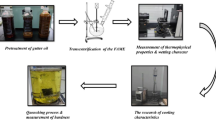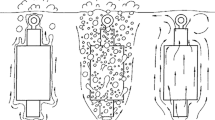Abstract
Previously, it has been shown by authors [1,2,3] that the addition of a special additives, for example PIB (polyisobutylene oligomer), creates an insulating layer on the surface of steel parts during quenching in mineral oils that eliminates film boiling without affecting physical properties of the oil. Insulating layer decreases initial heat flux density which becomes less than critical one. In current paper, the detailed investigations are provided concerning the mechanism of film boiling elimination or its cardinal decreasing due to presence a small amount of PIB in mineral oil. Experiments were made using Inconel 600 probe (10 mm in diameter and 30 mm long) which was quenched from 810 °C in I-8A, I-12A and I-20A oils. Effect of viscosity and molecular weight of PIB was investigated by authors. By elimination film boiling during quenching, it is possible to govern intensity of cooling and provide uniformity of hardening process. A phenomenon of eliminating film boiling due to presence a small amount of PIB in mineral oil is called EFB effect which has an important practical use.
Access provided by Autonomous University of Puebla. Download conference paper PDF
Similar content being viewed by others
Keywords
1 Introduction
It is well known that absence of film boiling, especially local film boiling, provides uniform cooling and decreases distortion [1,2,3]. According to existing approach, researches are trying to decrease duration of film boiling process by special additives affecting surface tension, viscosity, etc. Nobody paid attention to absolutely different approach consisting in creating an insulating layer on the surface of quenched steel parts. Such approach was proposed by authors [1] and is revolutionary because it affects duration of film boiling more effectively as compared with existing methods. The aim of current investigation is a study of the mechanism of film boiling elimination due to small addition of PIB (polyisobutylene oligomer) to I-8A, I-12A and I-20A mineral oils.
2 Experimental Investigations
2.1 Effect of PIB 2400 on Film Boiling Elimination (FBE Effect)
Figure 1 provides cooling curves and cooling rates [4] for solutions of PIB 2400 in different mineral oils at 50 °C. Mineral I-20A oil was investigated at different concentrations:1–0; 2–0.5; 3–1.0; 4–1.5; 5–2.0; 6–3.0 (see Fig. 1a); mineral oil I-12A at concentrations 1–0; 2–0.5; 3–1.0; 4–1.5; 5–2.0; 6–3.5 (see Fig. 1b) and mineral oil I-8A at concentrations 1–0; 2–0.5; 3–1.0; 4–2.0; 5–3.5; 6–10.0; 7–14.0 (see Fig. 1c). Some exact data are provided in Table 1.
Cooling curves and cooling rates for solutions of PIB 2400 in different mineral oils at 50 °C: (a), I-20A oil, concentrations 1–0; 2–0.5; 3–1.0; 4–1.5; 5–2.0; 6–3.0; (b), I-12A oil, concentrations 1–0; 2–0.5; 3–1.0; 4–1.5; 5–2.0; 6–3.5; (c), I = 8A, concentrations %wt 1–0; 2–0.5; 3–1.0; 4–2.0; 5–3.5; 6–10.0; 7–14.0.
It has been established by experiments that PIB 2400 can eliminate completely film boiling in mineral oil I-20A, however cannot eliminate completely film boiling in mineral oils I-12A and I-8A. Authors explain such behavior by decreasing critical heat flux densities of I-12A and I-8A oils. It means that small addition of PIB 2400 to I-20A oil provides FBE effect for 100% and for oils I-20A and I- 8A maximum for 80% – 90%. Authors explain such behavior by decreasing critical heat flux densities of I-12A and I-8A oils. It should be underlined that film boiling can be eliminated also at higher concentration of PIB 680 in I-20A oil (see Fig. 2).
Maximal cooling rates V maxt and duration of film boiling obtained for PIB 2400 and PIB 680 solutions in oil I 20A at 50 °C are shown in Fig. 3. Since it was impossible to explain decreasing or elimination film boiling during testing of small (10 x 30 mm) Inconel 600 probe in mineral oils by changing tension or viscosity (see Table 2), author came to conclusion that PIB addition creates thin coating on the surface of probe which decreases initial heat flux density and by this way decreases film boiling process or eliminate it completely [1,2,3,4,5]. This idea is a good hypothesis for further investigations of authors.
2.2 Effect of Molecular Weight of PIB on Duration of Film Boiling
It has been established by authors that exists a critical molecular weight of PIB which provides FBE effect. No effect at all when molecular weight of PIB is less than critical one (see Fig. 4 and Table 3).
To make final conclusion on mechanism of elimination film boiling process, one should do more thorough experiments with different additives.
3 Discussion
The approach of authors has a great practical importance because elimination of film and local film boiling results in decreasing distortion of steel parts after quenching. Especially, this problem is very important for bearing industry where elimination distortion can bring the huge benefits. To investigate carefully these processes, it is better to use Liscic/Petrofer probe [6] with three thermocouples instrumented in it. Also, critical heat flux densities and heat transfer coefficients should be carefully investigated to make possible controlling and governing quenching processes. For example, it was shown [5] that complete cooling during batch quenching in polymers of inverse solubility can lead to big distortion because dissolving of polymeric layer resulting in non – uniform cooling and martensitic transformations. To run technology correctly, one should deal with HTCs allowing make proper interruption to avoid big distortions. Thus, careful investigation of insulating layers will result in decreasing distortion and bring great benefits for industry.
4 Conclusions
-
1.
Low addition (3%) of PIB 2400 into mineral oil I-20A eliminates completely film boiling during quenching which is called FBE effect.
-
2.
Addition of PIB 2400 into I-8A and I-12A oils decreases film boiling process for 80% and 90% accordingly that is explained by lower critical heat flux densities of I-8A and I-12A oils.
-
3.
Oligomeric solutions in mineral oils, in contrast to water polymer solutions, do not follow the viscosity criteria.
-
4.
There is a critical molecular weight of PIB below of which FBE effect doesn’t take place.
-
5.
Mechanism and FBE effect is explained by formation an insulating layer on the metallic surface. It decreases initial heat flux density and makes it lesser than the first critical heat flux density [7].
-
6.
The FBE effect opens the great opportunity to optimize investigations on designing and content of the new oil quenchants for heat treatment of metals.
References
Kobasko, N.I.: Real and effective heat transfer coefficients (HTCs) used for computer simulation of transient nucleate boiling processes during quenching. Mater. Perform. Charact. 1(1), 1–20 (2012)
Lohvynenko, P.N., Moskalenko, A.A., Kobasko, N.I., Karsim, L.O., Riabov, S.V.: Experimental investigation of effect of polyisobutilene additives to mineral oil on cooling characteristics. Mater. Perform. Charact. 5(1), 1–13 (2016)
Kobasko, N.I., Moskalenko, A.A., Lohvynenko, P.N., Karsim, L.O., Riabov, S.V.: An effect of PIB additive to mineral oil resulting in elimination of film boiling during steel parts quenching. EUREKA: Phys. Eng. 3, 17–24 (2016)
ISO 9950 :1995(E): Industrial quenching oils – Determination of cooling characteristics – Nickel – alloy probe test method.- Geneva: International Organization for Standardization, 9p. (1995)
Kobasko, N.I.: Cooling intensity of inverse solubility polyalkylene glykol polymers and some results of investigations focused on minimizing distortion of metal components. EUREKA: Phys. Eng. 1, 55–62 (2017)
Liscic, B.: Measurement and recording of quenching intensity in workshop conditions based on temperature gradients. Mater. Perform. Charact. 5(1), 202–219 (2016). https://doi.org/10.1520/mpc20160007. ISSN 2165–3992
Kobasko, N.I., Moskalenko, A.A., Lohvynenko, P.N., Dobryvechir, V.V.: Maximizing critical and reducing initial heat flux densities to eliminate any film boiling and minimize distortion during quenching. EUREKA: Phys. Eng. 4(10), 33–41 (2017). https://doi.org/10.21303/2461-4262.2017.00366
Author information
Authors and Affiliations
Corresponding author
Editor information
Editors and Affiliations
Rights and permissions
Copyright information
© 2019 Springer International Publishing AG, part of Springer Nature
About this paper
Cite this paper
Lohvynenko, P., Moskalenko, A., Kobasko, N., Karsim, L., Riabov, S. (2019). Mechanism of Film Boiling Elimination During Quenching in Mineral Oils Caused by Oligomeric Additives. In: Ntalianis, K., Croitoru, A. (eds) Applied Physics, System Science and Computers II. APSAC 2017. Lecture Notes in Electrical Engineering, vol 489. Springer, Cham. https://doi.org/10.1007/978-3-319-75605-9_1
Download citation
DOI: https://doi.org/10.1007/978-3-319-75605-9_1
Published:
Publisher Name: Springer, Cham
Print ISBN: 978-3-319-75604-2
Online ISBN: 978-3-319-75605-9
eBook Packages: EngineeringEngineering (R0)








